|
Albany Metallurgical Research Center
|

|

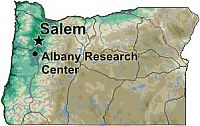
|

|
1450 Queen Avenue, S.W. , Albany , Oregon
Albany Research Center, owned by the U.S. Bureau of Mines, is located in Albany, Oregon. Metallurgical research was conducted at this site for the U.S. Atomic Energy Commission and the Energy Research and Development Administration from 1948 to 1978. Radioactive materials, including thorium and uranium, contaminated buildings, equipment, and soils.
The U.S. Bureau of Mines remediated portions of the site from 1948 to 1978. DOE conducted additional remediation of buildings, equipment, and soils under FUSRAP in 1987, 1988, 1990, and 1991. In 1992, DOE certified that, with the exception of areas where supplemental limits were applied, applicable cleanup criteria had been achieved, and the site was released for unrestricted use.
No institutional controls are in effect at the site, and DOE does not require on-site monitoring or surveillance. Legacy management activities consist of managing site records and responding to stakeholder inquiries.
5 files, last one added on Apr 30, 2006
Album viewed 499 times
|
|
|
Aliquippa Forge
|

|

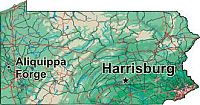
|

|
100 First Streeet , Aliquippa , Pennsylvania
Aliquippa Forge Site, now owned by the Beaver County Corporation for Economic Development, is located in Aliquippa, Pennsylvania. The Vulcan Crucible Steel Company heated and rolled uranium metal into rods for the U.S. Atomic Energy Commission (AEC) from 1948 to 1949, resulting in contamination of building exterior surfaces, equipment, and soil.
The former owner decontaminated the site to then-applicable guidelines in 1950 while under contract with AEC. DOE conducted additional remediation under FUSRAP in 1988, 1993, and 1994. In 1996, DOE certified that, with the exception of areas where supplemental limits were applied, applicable cleanup criteria had been achieved, and the site was released for unrestricted use.
No institutional controls are in effect at the site, and DOE does not require on-site monitoring or surveillance. Legacy management activities consist of managing site records and responding to stakeholder inquiries.
7 files, last one added on Apr 30, 2006
Album viewed 609 times
|
|
|
|
|
|
|
|
|
Burrell Disposal Cell
|

|

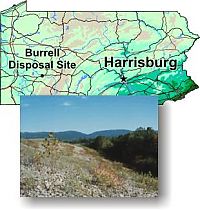
|

|
Uranium and other ores were processed at Canonsburg,
Pennsylvania, between 1911 and 1966. This milling
operation generated process-related waste and tailings,
a sandlike material containing radioactive materials and
other contaminants associated with the ore. In 1956 and
1957, tailings were removed from the Canonsburg site
and transported for use as fill on privately owned rail-road
property at Burrell Township, near Blairsville, Pennsylvania.
The Federal Government acquired the Burrell Disposal
Site through condemnation proceedings in 1986. The
U.S. Department of Energy (DOE) encapsulated the
tailings in an engineered disposal cell at the Burrell site
in 1987.
The U.S. Nuclear Regulatory Commission included the
Burrell Disposal Cell under general license in 1994. DOE is
responsible, under the general license, for the long-term
custody, monitoring, and maintenance of the site. The
DOE Long-Term Surveillance and Maintenance (LTSM)
Program at the DOE Grand Junction (Colorado) Office is
responsible for the long-term safety and integrity of the
disposal site.
In 1988, DOE established the LTSM Program to provide
stewardship of disposal cells that contain low-level
radioactive material after completion of environmental
restoration activities. The mission of the LTSM Program
is to ensure that the disposal cells continue to prevent
release of contaminated materials to the environment.
These materials will remain potentially hazardous for
thousands of years. As long as the cells function as
designed, risks to human health and the environment
are negligible
5 files, last one added on Apr 30, 2006
Album viewed 428 times
|
|
|
|
|
Canonsburg Mill
|

|

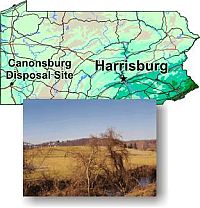
|

|
Location: The Canonsburg mill site is located in the Borough of Canonsburg, Washington County, Pennsylvania.
Background: From 1911 to 1922, the Standard Chemical Company operated a radium extraction plant on a 19-acre site in Canonsburg. Between 1930-1942, uranium and radium salts were extracted at the Canonsburg plant from residues and uranium ore. From 1942 to 1957, Vitro Manufacturing Company (later the Vitro Corporation of America) operated a mill at the site to recover uranium and rare metals from various ores and onsite residues, government-owned uranium ore, process concentrates, and scrap materials. The uranium concentrates produced by Vitro were sold to the U.S. Government. The waste products that accumulated at the site over its long history include residues generated by the incomplete extraction of radium, uranium, and other metals during processing of ore, byproduct chemical precipitates such as iron oxides and gypsum, process solutions, raw unprocessed ore materials, and uranium mill tailings. The total quantity of uranium/radium-bearing materials that were processed at the Canonsburg site during the periods of operation is not readily calculated based on the total radioactive waste volumes reported in the literature for the Canonsburg and Burrell sites. The uranium mill tailings were initially stored in uncovered piles, and the tailings material became dispersed by wind and water erosion. Some tailings material were also removed from the mill site for use as fill in local and regional construction projects. In 1956 and 1957, about 11,600 tons of mill tailings from the Canonsburg site were relocated to a railroad property near Blairsville in Burrell Township, Pennsylvania. After the Vitro uranium mill was closed down in 1957, the site was used until about 1966 as a storage facility under a contract issued by the Atomic Energy Commission. The land was purchased in 1967 by private interests and eventually became the Canon Industrial Park, a commercial park for light industrial use.
3 files, last one added on Jan 24, 2006
Album viewed 435 times
|
|
|
|
|
Connecticut Yankee (Haddam Neck)
|

|

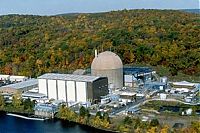
|

|
The plant was shut down on July 22, 1996. The fuel was removed from the reactor vessel on November 5, 1996. The owner submitted certification of permanent cessation of operations on December 5, 1996. The post-shutdown decommissioning activities report (PSDAR) was submitted August 22, 1997. The PSDAR public meeting was held on October 27, 1997. The owner submitted a License Termination Plan (LTP) on July 7, 2000. A public meeting on the LTP was held October 17, 2000. NRC completed its review of the LTP on November 25, 2002. The owner is using the DECON option.
45 files, last one added on Jul 17, 2006
Album viewed 1574 times
|
|
|
|
|
|
|
|
|
Kellex/Pierpont
|

|

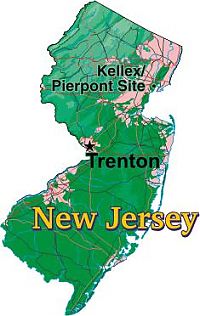
|

|
Kellex/Pierpont, Jersey City, NJ
Ownership of the Kellex/Pierpont Site, located in Jersey City, New Jersey, is divided between private interests and Jersey City. The Kellex Corporation was formed in 1943 to conduct engineering research in gaseous diffusion for uranium enrichment for the Manhattan Engineer District and the U.S. Atomic Energy Commission (AEC). From 1943 to 1953, site activities focused on fuel reprocessing and component testing with uranium hexafluoride, development of a solvent extraction process for the recovery of uranium, gas decontamination studies, and decontamination of waste streams.
DOE conducted a radiological survey of the site in 1977, and remediated those portions of the site with radioactive contamination between 1979 and 1983. DOE certified that the site complied with applicable cleanup criteria in September 1983 and, with State of New Jersey concurrence, released the property for unrestricted use.
1 files, last one added on Mar 22, 2009
Album viewed 329 times
|
|
|
|
|
|
|
|
|
|
|
Middlesex
|

|


|

|
Middlesex Sampling Plant (FUSRAP Site), Middlesex NJ &
Middlesex Municipal Landfill Site, Middlesex NJ
The Middlesex Sampling Plant is located in the Borough of Middlesex in New Jersey, approximately 56 kilometers (35 miles) northeast of Trenton and 42 kilometers (26 miles) southwest of Newark. The plant was established by the Manhattan Engineering District (MED), an early predecessor to the US Department of Energy (DOE), to sample, store and ship uranium and thorium ores. When MED operations ended in 1955, the Atomic Energy Agency (AEC), used this site to store and sample thorium. Primary contaminants at the site included uranium, radium, thorium, lead and organics. In the 1960s, all operations were terminated and all remaining thorium sampling activities were transferred. When AEC activities ended on the site, the area was decontaminated. EM completed this site as part of the Formerly Utilized Sites Remedial Action Program (FUSRAP). The FUSRAP Program was transferred to the United States Army Corps of Engineers (USACE) in 1997, in accordance with the Energy and Water Development Appropriations Act for FY 1998.
Ownership of the Middlesex North Site, located in Middlesex, New Jersey, is divided between the Middlesex Presbyterian Church and the Borough of Middlesex. In 1948, approximately 6,000 cubic yards of soil with radioactive contamination from the Middlesex Sampling Plant was disposed of at the landfill.
In 1961, the U.S. Atomic Energy Commission removed a portion of contaminated soil from the site and covered the area with 2 feet of clean soil. DOE designated the site for remediation under FUSRAP in 1980. In 1984 and 1986, DOE removed contaminated material from an area of approximately 3 acres at depths of 1 to 19 feet. DOE certified that the site complied with applicable cleanup criteria and released the property for unrestricted use in April 1989.
3 files, last one added on Mar 22, 2009
Album viewed 350 times
|
|
|
|
New Brunswick Laboratory
|

|


|

|
New Brunswick Lab, New Brunswick NJ
From 1948 to 1977, the New Brunswick Site, located in New Brunswick, New Jersey, operated as a general nuclear chemistry laboratory performing radiochemical analyses for the Manhattan Engineer District and the U.S. Atomic Energy Commission.
The site was partially remediated in two phases between 1978 and 1983, including removal of all aboveground structures, contaminated concrete foundations and on-site drain liners, and contaminated soils on the front two-thirds of the property. In 1990, DOE designated the site for additional remediation of residual soil contamination under FUSRAP. DOE remediated localized areas of contamination identified in 1996 and certified that the site complied with applicable cleanup criteria and standards in September 2001. The property was released for unrestricted use.
12 files, last one added on Feb 02, 2016
Album viewed 394 times
|
|
|
Niagara Falls Storage Site
|

|

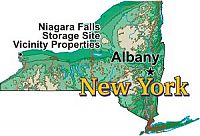
|

|
This site, located in Lewiston, New York, consists of 25 properties sold to private owners; the properties were formerly part of the Lake Ontario Ordnance Works. Another portion of the former ordnance works was transferred to the U.S. Atomic Energy Commission and became the Niagara Falls Storage Site.
Beginning in 1944, the Manhattan Engineer District stored uranium processing residues, uranium metal, and radiological waste at the Niagara Falls Storage Site. Radiological surveys of the site between 1970 and 1980 indicated that residual contamination had migrated off the Niagara Falls Storage Site primarily through drainage ditches and exceeded FUSRAP guidelines on 23 separate parcels, along a public right-of-way, and in the drainage ditches. Beginning in 1983, DOE remediated most of the vicinity properties to a condition that allows unrestricted use. The U.S. Army Corps of Engineers will complete closeout activities for the remaining properties.
1 files, last one added on Mar 22, 2009
Album viewed 403 times
|
|
|
|
|
|
|
|
|
|
|
|
|
|
Saxton
|

|

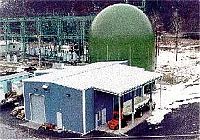
|

|
The plant was shut down in May 1972, and in February 1975 was placed in SAFSTOR until 1986, when phased dismantlement began with removal of support buildings, contaminated soil, and some material in the containment. The owner submitted a decommissioning plan in 1996, which became the PSDAR. All spent fuel has been removed from the site. The NRC approved an amendment request in 1998 to allow dismantlement under 50.59. The reactor vessel with internals, steam generator, and pressurizer have been shipped to Barnwell for disposal. The owner submitted a License Termination Plan (LTP) in February 1999, but had to resubmit the plan in February 2000 to provide sufficient information for an acceptance review. A public meeting on the LTP was held on May 25, 2000, at the Saxton Fire Hall to inform the public of the plan and receive public comments. The NRC is actively reviewing the LTP and is scheduled to complete the review by Second Quarter of 2003. The owner expects to complete decommissioning so the license can be terminated in the third or fourth quarter of 2003 and the site restored by the first quarter of 2004.
2 files, last one added on Feb 13, 2004
Album viewed 615 times
|
|
|
|
|
|
|
|
|
|
|
|
|
|
|
|
|
|
|
|
|
W. R. Grace & Co.
|

|

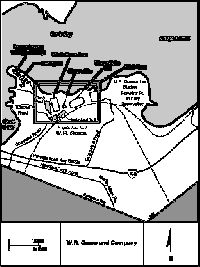
|

|
W. R. Grace and Company (FUSRAP Site) in Curtis Bay, Maryland
The W.R. Grace and Company is located on an industrialized peninsula in south Baltimore, Maryland. In the 1950’s the W.R. Grace and Company milled thorium for the Atomic Energy Commission (AEC), a predecessor agency for the US Department of Energy. W.R. Grace began processing radioactive materials at the site in the 1950s, when Rare Earths, Inc. (W.R. Grace’s predecessor) entered into a contract with AEC to extract thorium and rare earths from naturally-occurring monazite sands. Rare Earths’ contract with AEC and its license to possess, transfer and use radioactive thorium were transferred to W.R. Grace and Company. Building 23, where the thorium processing took place, was open until the late 1950s when the contract was terminated. The wastes were buried in a landfill area. Thorium processing resulted in low-level waste that was buried on the property. Radiation surveys have shown that radioactive contamination still persists in the waste burial area, the waste management area which surrounds the waste burial plot, surfaces surrounding vats and hoppers in Building 23 and alpha-radiation surface contamination in the whole of Building 23. The site was designated by DOE for remedial action under the Formerly Utilized Sites Remedial Action Program (FUSRAP) in 1984. This site was one of the 21 Formerly Utilized Sites Remedial Action Program (FUSRAP) sites where cleanup responsibility was transferred to the US Army Corps of Engineers in 1997 in accordance with the Energy and Water Development Appropriations Act for FY 1998. Cleanup responsibilities transferred at that time from DOE-EM to the USACE.
2 files, last one added on Mar 22, 2009
Album viewed 330 times
|
|
|
Wayne/Pequannock
|

|


|

|
Wayne Interim Storage Site (FUSRAP Site)
The Wayne Site is located about 3.2 kilometers (two miles) north of Wayne, New Jersey, in a highly developed area of Passaic County. The site is approximately 58 kilometers (36 miles) northwest of New York City. The W.R. Grace Company operated in the Wayne Township extracting rare earths from monazite ore and thorium between 1948 and 1971. Prior to 1960, radioactive thorium ores were placed in above ground piles. From 1960 to 1967, the thorium waste was buried in unlined pits. From 1967 to 1971, some of the waste was transported to Chattagnooga, TN. After production of materials was completed, partial decontamination of the site took place. The company covered the onsite disposal area and razed several buildings and burying the rubble. The remaining buildings were decontaminated and left intact. Vicinity properties that were contaminated via Sheffield Brook were also completely restored. EM completed this site as a part of the Formerly Utilized Sites Remedial Action Program (FUSRAP). The FUSRAP Program was transferred to the United States Army Corps of Engineers (USACE) in 1997, in accordance with the Energy and Water Development Appropriations Act.
2 files, last one added on Mar 22, 2009
Album viewed 318 times
|
|
|
West Valley
|

|

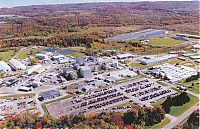
|

|
1961 While industrial interests explore the viability of commercial reprocessing, the state of New York moves to acquire land in the town of Ashford, near West Valley, for an atomic industrial area. The state Office of Atomic Development establishes the Western New York Nuclear Service Center (WNYNSC) on the 3,345 acres of land it has taken title to.
1962 Davison Chemical Company establishes Nuclear Fuels Services, Inc. (NFS) as a reprocessing company. It reaches an agreement with the state to lease the WNYNSC.
1966 Nuclear Fuels Services develops and operates 200 acres of the WNYNSC. It operates the site as a nuclear fuel reprocessing center from 1966 to 1972, and accepts radioactive waste for disposal until 1975. During the operation of the plant, 640 metric tons of spent reactor fuel are processed, resulting in 660,000 gallons of highly radioactive liquid waste. The liquid waste is stored in an underground waste tank. NFS also utilizes a 15-acre area for the disposal of radioactive waste from commercial waste generators, and another seven-acre landfill is used to dispose of radioactive waste generated from reprocessing.
1976 Following four years of pursuing modifications to the plant, NFS decides the costs and regulatory requirements of reprocessing make the venture impractical. The company decides to exercise its right to leave the site after its lease expires on December 31, 1980, transferring ownership and responsibility for the waste and facility to the state of New York. The state initiates talks with the Federal Energy Research and Development Administration to sort out ownership of the waste and environmental remediation responsibility.
1980 Congress passes the West Valley Demonstration Project Act, Public Law 96-368, directing the U.S. Department of Energy (DOE) to take the lead role in solidifying the liquid high-level waste and decontaminating and decommissioning the facilities at West Valley.
8 files, last one added on Mar 22, 2009
Album viewed 593 times
|
|
|
|
|
|
|
|
|
